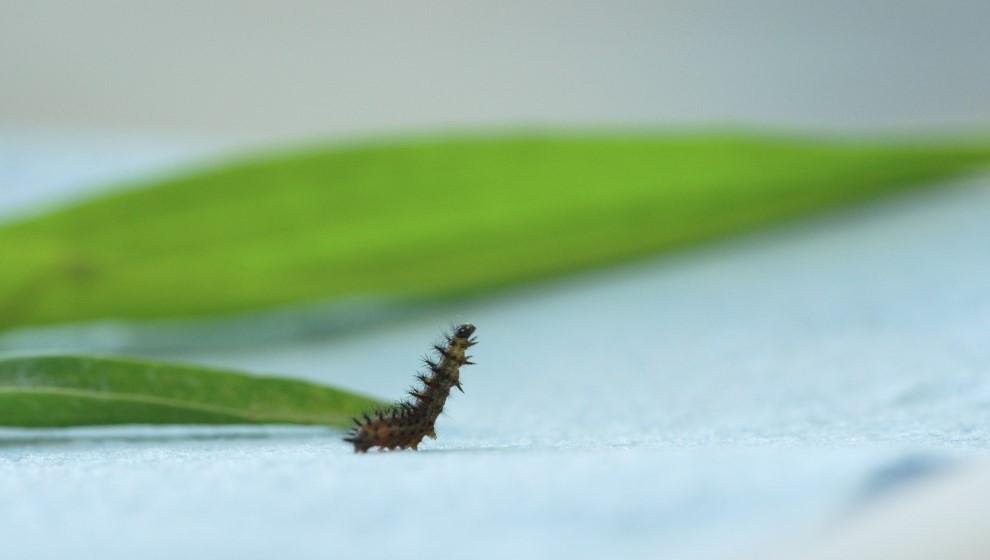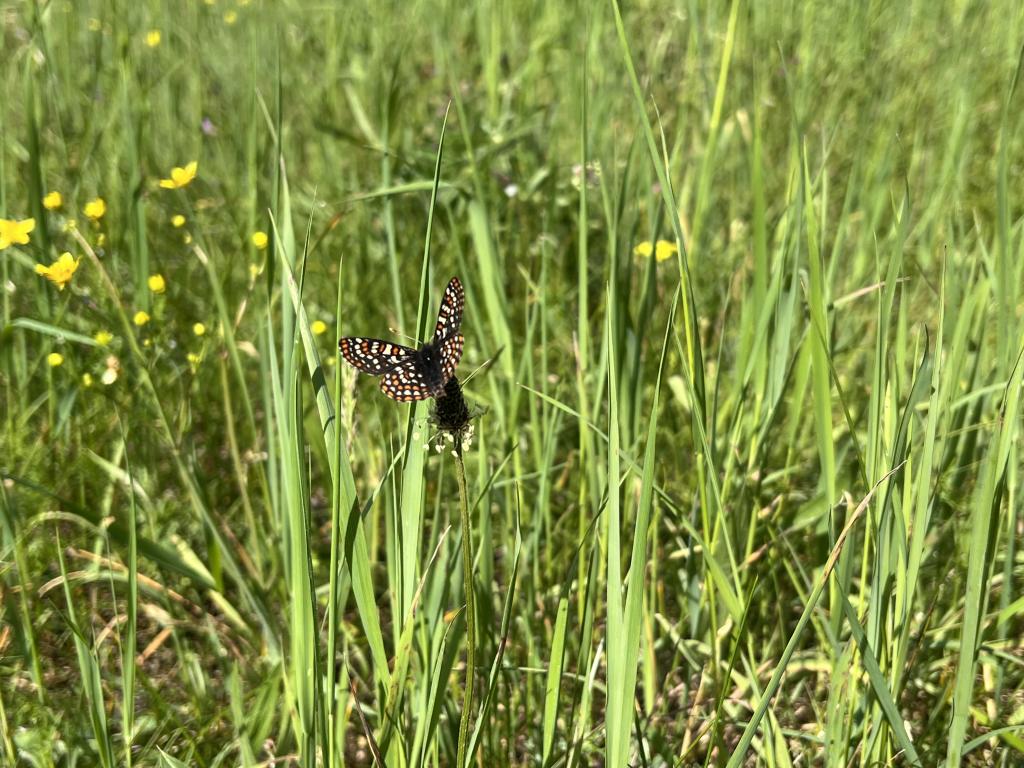By Annie Lamas, June 2024
A lock clicks and you’re granted entry into a long corridor. About eight steps in, the door slams behind you with an extremely loud acknowledgement of your location. At the end, a door opens with ID card access only into the main hall. As you walk through the central hallway, the smell of sauce hits your nose and you think, “I wonder if they’re having pizza today.” The housing unit you walk into smells like laundry and shampoo. Groups of women talk on the phone, sit at tables and chat, or turn their attention to the TV positioned above a classroom. Outside in the shared open space, Barn Swallows fly around, grabbing bugs out of the air and bringing them to their mud nests in the alcoves of the building. Western columbine, meadow checkermallow, and Douglas wallflower are putting on their best show with flowers of red, pink, and brilliant orange. Some women walk around the open space and chat, listen to music, workout, play basketball, go for a run, or lay out and tan. This is the setting for Coffee Creek Correctional Facility (CCCF), a medium-security women’s prison located in Wilsonville, Oregon. Within this facility, a dedicated team of 14 women are working to support the Taylor’s checkerspot butterfly (Euphydryas editha taylori). Seven women work within a captive rearing lab right on site and another seven tend the 5000 square foot yard that is growing their host plant, narrowleaf plantain (Plantago lanceolata).

The program began in 2017 with the help of Captain Chad Naugle, Oregon Zoo employee Ronda Naseth, former IAE Executive Director Tom Kaye, and former Ecological Education Program Director Stacy Moore. This team developed a plan to make the first and only captive rearing facility in the state of Oregon in the unique environment of a prison. Some of the women have been with the butterfly lab since the beginning and continue to use their knowledge and experience to train newer technicians. “As a lifer,” one butterfly technician remarks, “this was a rare opportunity to learn, train, and evolve from scratch the manual, positions, structures, etc.”, appreciating all the work that went into making this lab a reality. “I was offered this job when the lab was first beginning, but turned the offer down,” another butterfly technician comments, thinking about the other stressors that are present in a prison environment. “But when I felt that I was ready to make a new job change I applied, and it really has changed my life, in a variety of ways.”
Since 2017, the lab has had its ups and downs each season, the most extreme being an evacuation from nearby wildfires in 2020 and the onset of COVID-19. Volunteers and contractors were not allowed to visit, meaning the larvae were left in the care of the technicians with the detailed manuals that Ronda had left behind for them. That year, they successfully released over 1,000 larvae in the field, despite the challenges that season. One technician remembers the event very well: “I had 1,100 larvae sleeping under my bed!”
Despite the various challenges that have been presented in the lab since its inception, the butterfly team has successfully released over 10,000 Taylor’s checkerspot butterfly (TCB) larvae at restoration sites in the Willamette Valley, a truly remarkable accomplishment. The lab and the Plantago yard are a sanctuary for many of the women on the crew. One woman on the Plantago crew said that the program “helps with my anxiety, helps with my depression, gives me something to live for each day, and puts a smile on my face constantly.” Thirteen out of the 14 women on these teams are lifers, and this program, for many, “gives [them] a purpose and a chance to leave a positive impact on this earth,” one butterfly technician remarks. Even the newer crewmembers, just joining the Plantago and butterfly teams this past February, have expressed that “it has become not only my job but the one thing I look forward to being a part of every day. It is my passion, my therapy, and my classroom.”

It may be hard to imagine that this program is successful in a prison setting. Specifically on the captive rearing side, it can be very hard to maintain environmental controls in a lab setting, with the humidity, temperature, and lights being a constant factor that needs to be tinkered with every season. Despite the challenges, the women feel deeply connected to these small creatures, valuing every life and cherishing all the ups and downs. It was surprising to one butterfly technician “how their lives (the animals) mean so much to me. I’m cheering them on and feel the weight of their deaths.” They recognize that they are making a difference towards conservation and helping to increase the number of TCB in the wild. Not only are they learning about why this species is important, but they are passing the information to other women in the facility, to correctional officers and other DOC staff, and to their loved ones. One woman on the Plantago crew is surprised by how much she has learned and is proud of “how much I teach my kids and family about Plantago.”
I would be remiss if I did not mention the incredible amount of knowledge these women have gained from being a part of this program, with much of that learning coming from their own research outside of their daily jobs. Many of them are taking Portland State University classes at the facility and have expressed interest in becoming lepidopterists. The Lepidopterists’ Society, per request of the team, sends free copies of their peer-reviewed journal. The team hopes to publish in the journal one day. One member on the Plantago crew asked her family for a wildflower identification book and a copy of Pojar and McKinnon, a very popular plant and tree identification book for the Pacific Northwest. She is excited about the opportunity to learn more about native plants and how they benefit the environment. Apart from their own learning, we do our best to give them additional lessons on various ecology and conservation topics. They’ve had lessons on botany, soil science, symbiosis, parts of a flower, ecology of the Pacific Northwest, mammal skulls and skins, fertilizer and soil nutrients, ornithology, and much more. One woman on the Plantago crew expressed that she has learned “how much plants and living beings need each other”, with similar sentiments coming from one of the butterfly technicians: “Every life matters. No matter how big or how small.”

This program is a saving grace for each of the crewmembers. One woman from the Plantago crew exclaims that she has learned “that it is possible to have a feeling of home in doing something [she] loves,” knowing that her impact goes outside of the prison walls. Our newer butterfly technicians who are just getting their hands on husbandry this year, have realized that they are “way more valuable to [themselves] and to others and am capable of more than [they] give themselves credit for.” This is the piece of the program that holds so much meaning for me personally – the impact that knowledge and education have on people who are hungry for it and who are often forgotten by our society. It is amazing to watch them transition from being shy or reserved to asking more questions, becoming more confident, and sharing their thoughts.
Because we are outside the fence and unimpacted by slamming doors, we are compelled to tell their stories for them. However, their words are far more impactful. Here’s what they’d like you to know about the work they do:
“I wish people knew how deeply impactful our efforts are in working to preserve the Taylor’s checkerspot butterfly.” – CCCF Butterfly Technician
“This sustainable conservation job takes me out of a toxic stress environment…. This program has pushed me forward to continuing my education, hopefully staying on board with conservation and field research in my future.” – CCCF Butterfly Technician
“I wish that people not only knew about the wonderful things that the butterfly crew are doing together to help the butterflies but also the educational and therapeutic values that doing these jobs has for the AICs (adults in custody) at CCCF.” – CCCF Plantago Crewmember
“The work that I do here is so important to me.” – CCCF Plantago Crewmember
“How caring for an endangered species is extremely rewarding. Watching those tiny creatures through their cycles of life is stress relieving.” – CCCF Butterfly Technician
“That Plantago may be a weed but that is not how we see it…. To us Plantago is a life saver.” – CCCF Plantago Crewmember
“I wish people knew the importance of the work we do, and how crucial these butterflies are to our environment.” – CCCF Butterfly Technician
“I would like to let people know how much it means to me as a team member to take care of the Plantago field… and to be a part of taking care of endangered animals.” – CCCF Plantago Crewmember
“How unique and special it is within a prison setting.” – CCCF Butterfly Technician

If small actions can generate large changes, we think this is the best example of the butterfly effect. Thank you immensely to our funders and partners, U.S. Fish and Wildlife Service (USFWS), the Oregon Zoo, and Oregon Department of Corrections, especially Coffee Creek staff.
